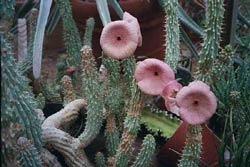Hoodia Gordonii Living Obesity Diet Drug
Desert Diet
Ancient Tribal Remedy Could Be Next Big Drug to Fight Obesity
By Matthew McGarry
L O N D O N, Aug. 7 A wild plant used by generations of native Bushmen in South Africa's Kalahari Desert to help them avoid starvation in the dry, hot sands could make them millionaires if it is successfully developed into a weight-loss drug for Westerners.
"I learned how to eat it from my forefathers," said one member of the San tribe, a people who live in the Kalahari Desert, as he prepared a piece of the cactus-like plant called hoodia by trimming off the prickly spikes. "It is my food, my water, and also a medicine for me." Hoodia Gordonii Cactus Diet Drug
According to San spokesman Andries Steenkamp, his people ate the hoodia plant for thousands of years in order to ward off hunger pains and to quench their thirst during lean times and when they were forced to survive during long hunting trips.
"Hoodia gordonii cactus stops hunger and also treats sickness," Steenkamp told ABCNEWS. "We, San, use the plant during hunting to fight off the pain of hunger and thirst."
Pfizer Developing Key Ingredient for diet drug hoodia
Now drug firms are tapping into the San knowledge, and are hoping to make a fortune by developing the hoodia plant into a miracle slimming pill for millions of overweight Americans and Europeans.
One of those firms is Pfizer, the U.S. pharmaceutical giant responsible for Viagra. It has invested as much as $21 million for the rights to develop and license the active ingredient of hoodia, called P-57.
Obesity is a growing problem in Western countries, where 100 million people are dangerously overweight. Doctors say excessive weight gain causes a myriad of medical problems including heart disease, diabetes, cancer and the onset of strokes.
P-57 works by mimicking the effect that glucose has on nerve cells in the brain — in effect fooling the body into thinking it is full, even when it is not, thus curbing the appetite.
Clinical trials of the hoodia gordonii diet drug in the United Kingdom suggest P-57 could reduce appetite by up to 2,000 calories a day, making it a potential runaway success in the multimillion-dollar dieting industry. Developers of P-57 hope to see it available as a prescription diet drug by 2007, after further clinical trials.
The irony that some of the world's most overfed people may benefit from some of the hungriest was not lost on the San.
"At first people here were a bit shocked," said Nigel Crawhall, a professor at the South African San Institute and a campaigner for the rights of indigenous tribes. "Why would anybody want to lose weight by eating the hoodia cactus plant? Because it's meant for when you're traveling across the desert and you don't have enough to eat. So we thought it was a bit weird."

Promised a Cut in Profits
A tribe of hunter-gatherers whose 20,000-year-old culture was recently close to extinction, the San people could now have found the ultimate survival weapon in their reliance on hoodia cactus. Pfizer has promised them a cut of the royalties.
But the chance to share in the proceeds of a revolutionary new diet drug didn't come without a fight.
Roger Chennells, a lawyer who in 1999 helped the San win back a large portion of their ancestral homelands in South Africa, decided to challenge the drug firms and the South African research institute that originally took out the hoodia patent in 1996.
After a prolonged battle an agreement was finally reached earlier this year. "There was a certain amount of mistrust because it was a significant amount of money and each side had a lot to lose," said Chennells. "But after a fight, both parties were satisfied."
Now the San will help to cultivate the plant and should the drug come to market, their impoverished community of an estimated 100,000 people scattered across the Kalahari Desert stands to gain millions of dollars annually, plus jobs and scholarships from the hoodia cactus.
Dreams of Riches
But first the drug must be proven to work and then it must be declared safe to use by government medical boards.
Crawhall said the mood is one of anxious anticipation. "There are lots of promises, and lots of excitement, but people have seen promises before and they don't always deliver, so there's also a bit of caution," he said. "People can't help but wondering if this is really going to happen or not."
In the meantime, the needy San people continue to hang on to life in the harsh and unforgiving Kalahari Desert, comforted by dreams of future riches and how they will spend all that money from the hoodia cactus diet drug.